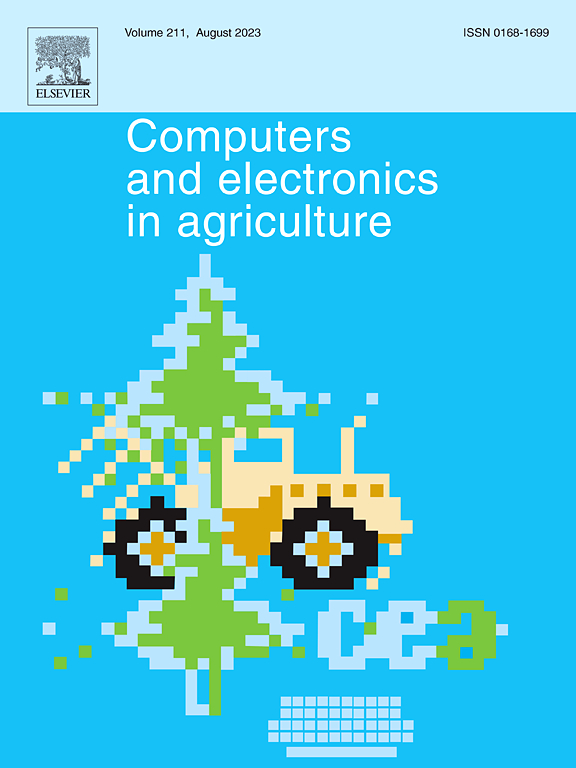基于多模态无人机图像零射分割的杨树幼苗生物量田间表型评价
IF 8.9
1区 农林科学
Q1 AGRICULTURE, MULTIDISCIPLINARY
引用次数: 0
摘要
杨树因其生态效益和经济效益而被广泛种植。研究杨树幼苗的表型,可以选择最优的栽培方法,提高产量和品质。基于无人机的低空遥感与光学传感器为此类研究捕获图像和光谱数据。然而,无人机植物表型的深度学习面临着需要大量时间和精力来标记图像样本以进行模型训练的挑战。本研究旨在评价基于接地DINO-SAM2的杨树多基因型单株零芽实例分割的有效性。自动程序计算RGB和多光谱掩模区域的图像特征,包括冠层投影、颜色、纹理和光谱反射率,然后根据两年的数据建立生物量估算模型。研究结果如下:(1)利用接地DINO-SAM2模型对400张图像数据进行了零标记样本实例分割。在不到15 min的时间内对目标识别量不正确的样本进行修改后,整个模型耗时仅0.5 h,精度达到0.943,与主流的全监督分割模型相比,大大节省了时间和计算成本。(2)建立了基于多模态图像特征的杨树幼苗生物量估算模型。通过对单传感器与多传感器结合不同建模算法的对比优化,发现CNN测试集准确率(R2)达到0.823。本研究为植物图像分割和特征提取提供了一种轻量级、高性价比的方法,促进了农林智能管理和监测的发展。本文章由计算机程序翻译,如有差异,请以英文原文为准。
Field-based phenotyping for poplar seedlings biomass evaluation based on zero-shot segmentation with multimodal UAV images
Poplar trees are widely cultivated for their ecological and economic benefits. Studying the phenotypes of poplar seedlings can enable the selection of optimal cultivation methods to enhance yield and quality. UAV-based low-altitude remote sensing with optical sensors captures images and spectral data for such studies. However, deep learning in UAV plant phenotyping faces the challenge of requiring substantial time and effort to label image samples for model training. This paper aims to assess the efficiency of using Grounding DINO-SAM2 for zero-shot instance segmentation of individual poplar seedlings across multiple genotypes. An automatic program calculates image features from RGB and multispectral mask areas, including canopy projection, color, texture, and spectral reflectance, which are then used to establish a biomass estimation model based on two years of data. The study obtained the following results: (1) The Grounding DINO-SAM2 model was used to implement zero-labelled sample instance segmentation of 400 image data. After modifying the sample with incorrect target recognition quantity in less than 15 min, the total model took only 0.5 h, with a precision of 0.943, which greatly saved time and computing cost compared with mainstream fully-supervised segmentation models. (2) A poplar seedling biomass estimation model based on multimodal image features was established. After comparing and optimizing single-sensor and multi-sensor combined with different modelling algorithms, it was found that the CNN test set accuracy (R2) reached 0.823. This research provides a lightweight, cost-effective approach for plant image segmentation and feature extraction, promoting advances in intelligent management and monitoring for agriculture and forestry.
求助全文
通过发布文献求助,成功后即可免费获取论文全文。
去求助
来源期刊

Computers and Electronics in Agriculture
工程技术-计算机:跨学科应用
CiteScore
15.30
自引率
14.50%
发文量
800
审稿时长
62 days
期刊介绍:
Computers and Electronics in Agriculture provides international coverage of advancements in computer hardware, software, electronic instrumentation, and control systems applied to agricultural challenges. Encompassing agronomy, horticulture, forestry, aquaculture, and animal farming, the journal publishes original papers, reviews, and applications notes. It explores the use of computers and electronics in plant or animal agricultural production, covering topics like agricultural soils, water, pests, controlled environments, and waste. The scope extends to on-farm post-harvest operations and relevant technologies, including artificial intelligence, sensors, machine vision, robotics, networking, and simulation modeling. Its companion journal, Smart Agricultural Technology, continues the focus on smart applications in production agriculture.
 求助内容:
求助内容: 应助结果提醒方式:
应助结果提醒方式:


